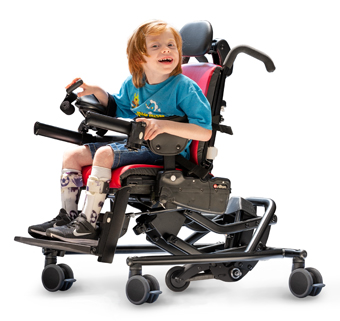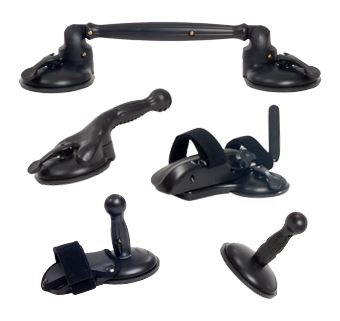Independence Saddle
by Karen Szymas, founder of Independent Strides, LLC
| September 2006
I’ve been an equestrian my entire life. At the tender age of two weeks, I was already on horseback in my mother’s arms. At the age of three, my formal equestrian training began. Extensive training made it possible for me to successfully compete on many levels, including Quarter Horse Congress, the world’s largest single breed horse show–where I won numerous top ten titles.
During my early teens, my parents developed a therapeutic horseback riding instruction program for a local developmental center in Michigan. Through volunteering and assisting my mother in running this program, I began working with individuals with special needs. Working with adults and children in equestrian therapy was a gratifying experience with one exception–I was always frustrated, saddened and troubled that adults and children with the most severe impairments were excluded from equestrian therapy programs.
There is a familiar discipline in the equine world–“form to function”: Without proper physical form, it is difficult to function. I also believe that with determination, adaptive techniques, and proper equipment, anyone, regardless of physical or cognitive impairment, can reach their full potential.
 Linda Bidabe, founder of MOVE, has said: “I believe that if a person who has difficulty sitting is provided equipment with forearm supports, that person will be able to sit independently.” Those words were my inspiration.
Linda Bidabe, founder of MOVE, has said: “I believe that if a person who has difficulty sitting is provided equipment with forearm supports, that person will be able to sit independently.” Those words were my inspiration.
The idea for a saddle design formed in my mind: an Australian Saddle with adjustable forearm supports and handgrips, a backrest and headrest. The saddle would have a variety of prompts that would be gradually reduced to allow for more independent sitting on horseback. These concepts were based on the MOVE philosophy.
At the first opportunity, I shared my drawing and ideas with Linda. She offered her enthusiastic support and urged me to follow through with my design.
I began a challenging but memorable four-year journey. Design engineers took my ideas and tested the specifications to insure the integrity of the saddle. As more people became involved in this saddle project, I was amazed at their remarkable willingness to go above and beyond what was asked of them. They were eager to be associated with a project that had such enormous potential to help people with multiple impairments.
Finally, the most exciting stage was reached–testing the saddle with children on horseback. It became clear that I was witnessing a tremendous breakthrough in seeing children sitting independently in my saddle. No one had to say anything. The wide smiles and happy tears expressed it all.
 Of all the individuals encountered during the saddle testing, one person stood out. Haley, a 16-year-old girl with cerebral palsy, loved riding horses, but for many years, could only ride with her brother sitting behind her to hold her in the saddle. Haley and her parents heard about the saddle project and immediately contacted me asking if Haley could try the saddle. When Haley got on the saddle, it was such a big success and Haley’s parents purchased the first saddle. Haley is now the proud owner of Independence Saddle serial number 1.
Of all the individuals encountered during the saddle testing, one person stood out. Haley, a 16-year-old girl with cerebral palsy, loved riding horses, but for many years, could only ride with her brother sitting behind her to hold her in the saddle. Haley and her parents heard about the saddle project and immediately contacted me asking if Haley could try the saddle. When Haley got on the saddle, it was such a big success and Haley’s parents purchased the first saddle. Haley is now the proud owner of Independence Saddle serial number 1.
Within weeks of Haley using the saddle, her parents saw marked improvement in both her physical and emotional health. The curvature of her spine decreased, her strength and flexibility improved dramatically, her appetite increased and, most importantly, she developed a new self-confidence and a fresh enthusiasm for life. Haley’s story, among many others, inspired me to finally achieve completion of the saddle project.
For me, in the four-year process of development of the Independence Saddle, the most gratifying event occurred on June 19, 2006. On that day, I met with the MOVE International Board of Directors in Bakersfield, California, to enter into a formal agreement with MOVE International and Independent Strides, LLC. The board concluded that the saddle is compatible with the MOVE philosophy and for use in the MOVE Program. I was proud and honored on that day to realize the board not only understood, but also believed in my dream of the Independence Saddle and the great potential for the saddle to improve the quality of life for the many people with special needs and their families.
Linda Bidabe notes:
One of the biggest issues for horseback riding for people with severe disabilities is the need for a back rider. In addition to the back rider, there are two side walkers and someone leading the horse. The side walkers are holding onto the person while the back rider had his/her arms around the person.
I had to ask myself how much real independence was there with all these people “attached”? The Independence Saddle eliminates the back rider. It is also much easier on the horse not to have the second person sitting behind the person with the disabilities.
Of course, there are still side walkers and they are very alert and right there. But the side walkers no longer have to hold the person up. That gets very, very tiring and very taxing. The side walkers are still there for the sake of safety so they can get the rider off quickly if need be and so they can reassure the rider.
If we want children to grow up and be independent, we better find a variety of ways for them to experience that, before they’re an adult.
For more information, contact:
Independent Strides
P.O. Box 768
Phone: (616) 296-9301 Toll Free: (866) 630-1901
www.independentstrides.com
This article reprinted with permission from:
MOVE International Fall 2006 Newsletter
1300 17th Street
CITY CENTRE
Bakersfield, CA 93301-4533 USA
800-397-MOVE(6683)
www.move-international.org




